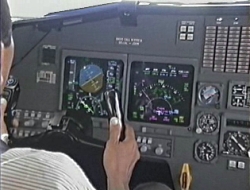Stick
shaker. An artificial stall warning system is required for
airplane certification if the natural prestall buffet characteristics of the
airplane are insufficient to warn the flight crew of an impending stall. This
warning must be in a form other than visual to be effective, even if the flight
crew is not looking at the instrument panel. Beginning with early commercial
jetliners, standard practice has been to equip these airplanes with a stick
shaker as a means of stall warning. Some airplanes also have employed stick
nudgers or stick pushers to improve stall avoidance and stall characteristics.
All these indications have been driven by an AOA threshold, which is usually a
function of flap configuration, landing gear configuration, or both.
Because of the effect of Mach
number on stall AOA, the stall warning AOA typically was set at a conservative
level to accommodate gross weight and altitude variations expected in the
terminal area.
It should be noted that the
stall warning schedule does not follow the buffet boundary at very high Mach
numbers. The buffet here is caused by Mach buffet, or too high a speed. Setting
the stall warning system to activate at this point may lead the flight crew to
believe the airplane is near stall and increase, rather than decrease, speed.
The early stall warning system thresholds were not set to be effective
at cruise altitudes and speeds because they did not correct for Mach number. This
kept the system simple. The stick shaker was set at an AOA effective for low
altitudes but at too high a value for cruise. Natural stall buffet was found to
give satisfactory warning at higher Mach numbers.
Later
stall warning systems used Mach number from the pitot or static air
data system to adjust the stall warning AOA threshold down as Mach number
increased. This provided the flight crew with a stall warning related to the
actual available performance. However, it also made the stall warning system
dependent on good pitot and static data, a factor that will be considered in
the next section on the dedicated AOA indicator.
SYSTEM
ANOMALY RECOGNITION AND RECOVERY TECHNIQUES
Regardless of the nature of
erroneous flight instrument indications, some basic actions are key to
survival. The longer erroneous flight instruments are allowed to cause a
deviation from the intended flight path, the more difficult recovery will be.
Some normal procedures are designed, in part, to detect potential problems with
erroneous flight instruments to avoid airplane upsets. Examples are the 80-kn
call on takeoff and callouts for bank angle exceedances. In some cases the
flight crew may need to recover the airplane from an upset condition:
unintentional pitch greater than 25 deg nose high or 10 deg nose low, bank
angle in excess of 45 deg, or flying at airspeed inappropriate for conditions.
As the condition deteriorates, it becomes more dynamic and stressful. This
stress increases the difficulty flight crews experience in determining,
believing, and adjusting to using the correct instruments and ignoring the
faulty instruments. Regardless of the situation, good communication between
crewmembers is essential, and several basic actions are paramount:
Recognizing
an unusual or suspect indication.
Keeping
control of the airplane with basic pitch and power skills.
Taking
inventory of reliable information.
Finding
or maintaining favorable flying conditions.
Getting
assistance from others.
Using
checklists
ACCIDENT
AND INCIDENT CASE STUDIES
Erroneous flight
information such as the many and varied
symptoms of pitot-static anomalies can confuse an unprepared flight crew.
Because of the confusion caused by multiple and sometimes conflicting alerts
and warnings, the flight crew may not recognize an air data error and may fail
to respond appropriately. The following accidents and incidents show what can
happen when a crew is confronted with unreliable or erroneous flight
information.
In
December 1974, a Boeing 727 crashed 12 min after takeoff
while on a positioning flight from Buffalo, New York, in the United States. Three
crewmembers were killed and the airplane was destroyed. The U.S. National
Transportation Safety Board (NTSB) determined that the probable cause of the
accident was flight crew failure to recognize and correct the airplane's high
angle of attack and low speed stall. The stall was precipitated by the crew's
reaction to erroneous airspeed indications caused by atmospheric icing blockage
of the pitot probe. The pitot heat switch had not been turned to the ON
position.
In April 1991, the
crew on a large corporate jet survived the following incident. On the previous
leg, the captain's airspeed/Mach indicator and the standby airspeed/Mach
indicator were erratic. The ground crew was unable to duplicate the problem.
The next leg was at night in visual conditions. It was uneventful until the
crew observed the first officer's airspeed/Mach indicator begin an uncommanded
increase as the airplane climbed through FL310. Passing FL330, the captain's
airspeed remained steady, but the first officer's airspeed pointer exceeded
"barber pole," and the high-speed aural clacker activated. The
autothrottles were disconnected, and at that point the captain's airspeed
indicator began to show a decrease in airspeed that coincided with the standby
airspeed/Mach indicator. Because of problems reported on the previous leg, the
crew assumed that the captain's instruments were faulty. As the first officer's
airspeed/Mach indicator kept increasing, the crew pulled the power back to
silence the clacker, but the first officer's airspeed continued to increase and
the captain's airspeed indicator continued to decrease. The airplane began to
shake, which the crew assumed was high-speed Mach tuck. At FL340, the pitch was
increased and stick shaker activated. The crew suddenly realized that they were
entering a stall. While performing stall recovery procedures, they experienced
severe vertigo, spatial disorientation, and confusion over determining the
actual airspeed. Though the clacker was still sounding, fuel flow, attitude,
and N1 were calculated for descent. Appropriate checklists were run and the
circuit breakers were pulled to silence the clacker. Using calculated attitude
and power settings, a descent, instrument landing system approach, and
uneventful landing were accomplished. Maintenance later confirmed that the
first officer's central air data computer had failed.
In
February 1996, a Boeing 757 crashed after takeoff from the International
Airport of Puerto Plata, Dominican Republic. After climbing through 7,300 ft,
the airplane descended until it crashed into the Atlantic Ocean about 5 mi off
the coast of the Dominican Republic. All 189 people on board were killed, and
the airplane was destroyed. Data from the cockpit voice recorder (CVR) and
flight data recorder (FDR) indicate that the airspeeds displayed to the captain
during the takeoff roll were incorrect and that the captain was aware of this
during the takeoff roll. Nevertheless, the captain decided to continue the
takeoff, and the first officer notified the captain when the airplane reached
V1 and Vr. Shortly after takeoff, the captain commented that his airspeed
indicator had begun to operate, even though it indicated unrealistic airspeeds.
A normal climbout ensued, and the captain engaged the center autopilot. During
the climb, at an altitude of 4,700 ft, RUDDER RATIO and MACH/SPD TRIM advisory
messages appeared on the engine indication and crew alerting system display
unit. For the next several minutes, the crewmembers discussed the significance
of these advisory messages and expressed confusion about the airspeed. At an
altitude of about 7,000 ft, the captain's airspeed indicator showed 350 knots,
and an overspeed warning occurred, immediately followed by activation of the
stall warning system stick shaker. Flight crew confusion about appropriate
airspeed, thrust setting, and proper pitch attitude was evident as the airplane
stalled, descended, and then crashed. The erroneous readings from the captain's
airspeed indicator are consistent with a blocked pitot tube. Comments by the
first officer recorded on the CVR suggest that his pitot probe was not
obstructed, and he was seeing correct airspeed indications on his display.
In
October 1996, a Boeing 757 crashed into the Pacific Ocean about 30 mi off
the coast of Lima, Peru. The flight crew declared an emergency immediately
after takeoff because of erroneous airspeed and altitude indications and was
attempting to return to Lima when the accident occurred. Data from the CVR and
FDR revealed that the airspeed and altitude readings were normal during the
takeoff roll. However, as the airplane began to climb, the flight crew noticed
that the airspeed indications were too low and the altitude indications were
increasing too slowly. Shortly after takeoff, the windshear warning activated, despite calm wind conditions and no
significant weather activity. The flight crew declared an emergency and
expressed confusion about the airplane's airspeed and altitude displays.
Analysis of FDR data indicates that the airplane subsequently climbed to a
maximum altitude of approximately 13,000 ft. When the airplane descended, the
captain's altitude and airspeed displays were still erroneous, but at that
point they indicated higher-than-actual conditions. During descent, the first
officer's displayed airspeed slowed to the point of stall warning stick shaker
activation. Meanwhile, the captain's airspeed read over 350 knots, and the
overspeed warning was sounding. Flight crew confusion about airspeed and
altitude was evident as the airplane continued its final descent. At impact
into the Pacific Ocean, the captain's flight instruments were reading
approximately 9,500 ft and 450 kn. The erroneous indications recorded by the
FDR are consistent with a partial blockage of the captain's static ports.
Three valuable lessons emerged from the
investigations of these events. First, the effects of flight
instrument anomalies appear during or immediately after takeoff. Second,
flight crews must overcome the startle factor associated with rare anomalous
events and immediately begin to implement specific corrective procedures and
techniques. Finally, flight crews should acquire enough system knowledge
to be able to determine the difference between valid and faulty display information.
AOA –
Angle of Attack probe has been used as a
primary performance parameter for years on some military aircraft, particularly on fighters. There are many good reasons for this.
In general, fighters operate
more often at the extremes of the envelope, often flying at maximum lift for minimum radius turns.
For other applications, AOA minimizes the pilot (usually single-place)
workload by
giving a simple target to fly. AOA is accurate enough for these applications. In
addition, the higher sweep and lower aspect ratio of the wing reduce the
sensitivity to AOA errors.
AOA has proved particularly
useful for approach to aircraft carriers, where it is important to maintain a
consistent approach attitude for each landing. In this case, 'backside'
approach techniques are used, where glide path is controlled primarily by
changes in thrust while the aircraft is held at a fixed AOA. Use of this
technique during approach on commercial jet airplanes would be contrary to the
pitch commands provided by the flight director bars, and to the speed hold mode
of the autothrottle, which is often used during approach.











